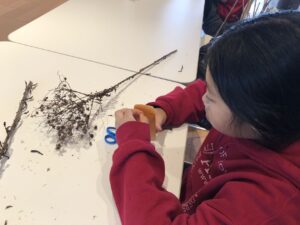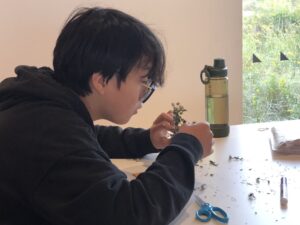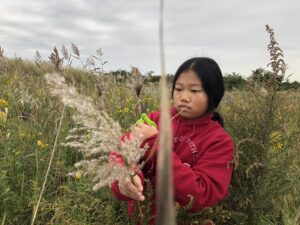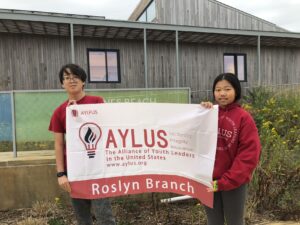On Sunday October 14, 2023, from 9:30 am to 12:00 am the Roslyn AYLUS branch volunteered at the Jones Beach Energy & Nature Center.
We were given a quick briefing on the invasive plants and how we would remove them. The invasive plants we removed were called Phragmites, a quick-growing reed that can outgrow native species and compete with them for resources. We were instructed to dead-head the Phragmites. Deadheading involves removing the seed head of a target species before it can go to seed. While this will not kill the perennial species, it will prevent them from further spreading the seed. This also leaves the plant in a vulnerable position by making them shorter than the native plants and starving the phragmites of sunlight. Reducing the chance of them surviving and spreading. The Roslyn branch along with other volunteers quickly and efficiently beheaded multiple acres of Phragmites in turn saving the natural environment. As we worked the rain started falling and proceeded to get stronger. But we persevered and carried on until there were no more Phragmites. Eventually, a drizzle became a downpour and we had to seek shelter in the geo-thermally warmed and solar-powered nature center.
We were then instructed to remove seeds from 3 beneficial native plants put them into packets and label the packets. The 3 essential plants were New England Aster, Coneflower, and Black-eye Susan. The nature center would then hand these packets out free of charge to visitors. Then the team split up, vigorously separating seed from the plant and seed to packet. The first beneficial plant was the New England Aster, a plant with many magenta-colored flowers and feathered seeds similar to dandelions. The process for removing the seeds from the Aster was the simplest, all we had to do was gently pull on the dried florets and the seeds would come out in dozens. The next plant was the Black-eyed Susan an elegant flower with brilliant yellow petals and seeds reminiscent of black sprinkles. The process to remove these seeds was also relatively simple, if you rubbed on the seed head a mixture of seed and chaff would come out. The hard part was removing the seed from the chaff. Chaff is the dry, scaly protective casing of the seeds which was slightly lighter and bigger than the seeds. Finally was the Coneflower, a flower that came in a rainbow of colors and a seed that looked similar to rice. The task of extracting a seed from a coneflower was an arduous one with a very small amount of seeds not proportional to the amount of work one puts in. There is no effective way to extract the seeds, some people would peel the spiky floret with much difficulty only to be rewarded with a few seeds. Others would scrap the seed head against the edge of a scissor to get seeds.
After we extracted seeds from each plant, we would put a generous amount of seeds into each packet and seal them. The last part of the process was labeling them, a very fun and rewarding process for the hard work we did. This was because many of the volunteers took creative liberties in labeling the packets. Some would draw flowers and smiley faces on the packets, while others would write jokes on the packets. One example is “Who is Susan and why does she have a black eye?”. In the end we ended up with a mountain of packets for the nature center and a even larger mountain of Phragmites ready for disposal. With our work, we were able to clear acres of invasive plants that threatened native plants and provide the Nature Center with seed packets to give to guests.
Members who participated include: Hunter Chen (2.5 hours) and Natalie Tsui (2.5 hours)
Reporter: Hunter Chen





